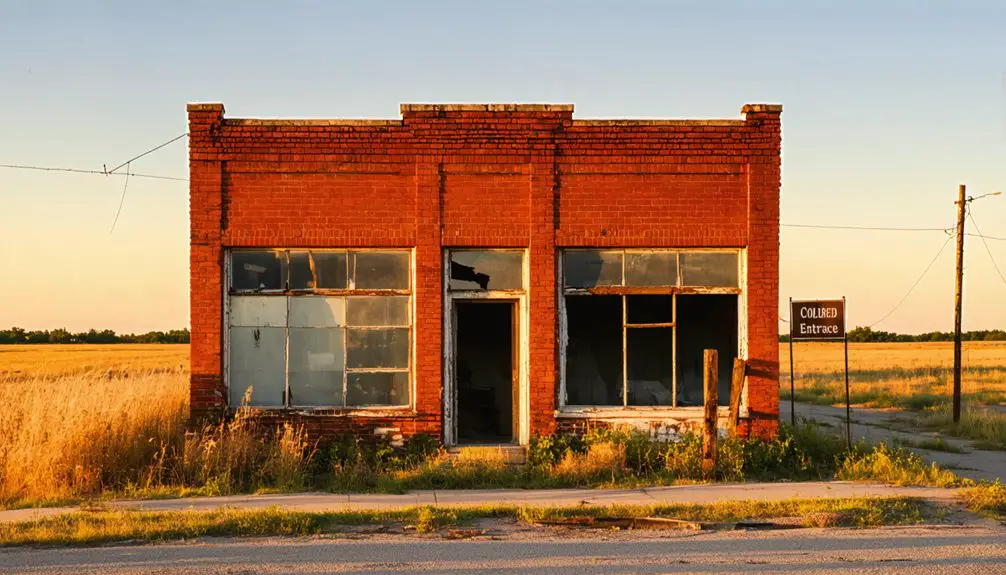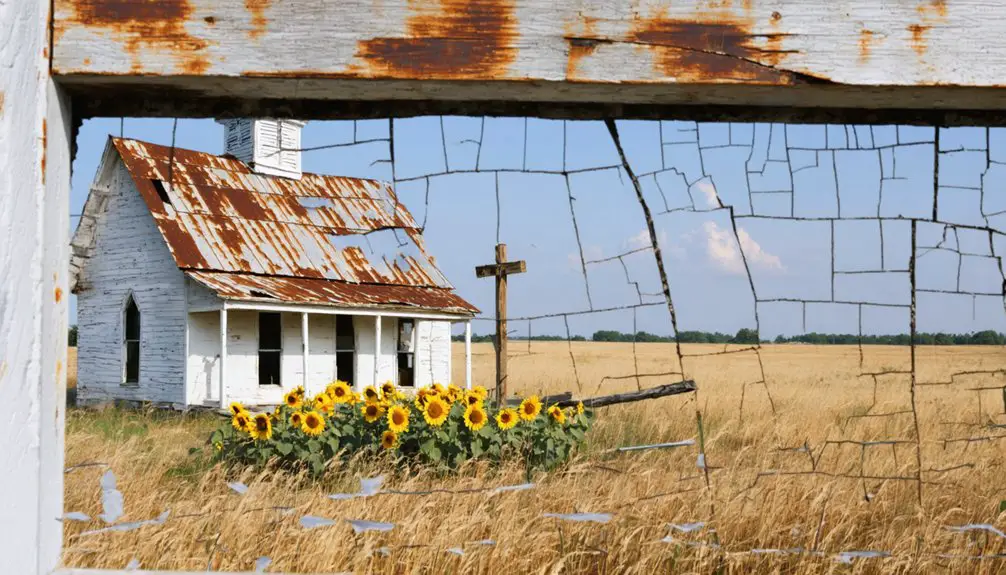You’ll find Wybark, Oklahoma four miles north of Muskogee, where an all-Black settlement sprang to life in 1890. This vibrant community centered around farming, local churches, and a post office, representing freedom and self-determination for formerly enslaved people. As younger residents left during the Great Depression and economic changes swept through, Wybark gradually faded into a ghost town by 1940. Its story mirrors the broader tale of Oklahoma’s historic Black settlements and their dreams of autonomy.
Key Takeaways
- Wybark was an all-Black settlement established in 1890 near Muskogee, Oklahoma, which later became a ghost town after its post office closed in 1940.
- The community thrived through farming and livestock production but declined during the Great Depression when younger residents moved to urban areas.
- Located four miles north of Muskogee, Wybark represented African American self-determination and autonomy during the territorial period of Oklahoma.
- No visible structures or landmarks remain of the original settlement, with the town site now absorbed into modern boundaries.
- The settlement’s decline followed typical patterns of Oklahoma ghost towns, affected by railroad isolation and lack of economic diversification.
The Birth of a Black Settlement (1890)
As African Americans sought refuge from the post-Civil War South, Wybark emerged as one of Oklahoma Territory’s all-Black settlements in 1890.
Located just four miles north of Muskogee, this community represented the dreams of freedom and self-determination that drew thousands to the region during the late 19th century.
Despite founding challenges, Wybark’s settlers established a functioning post office and built their community alongside other African American towns sprouting across the territory.
The settlers maintained mutual protection and security by living together in close-knit groups, following patterns established by freedmen throughout Indian Territory.
Their cultural resilience shone through as they absorbed parts of the older North Fork settlement and created a haven where Black entrepreneurs could thrive.
You’ll find that Wybark’s story mirrors the broader movement of freedmen and Southern Black migrants who saw Oklahoma Territory as their “Promised Land” – a place to build autonomous communities free from the oppression they’d left behind.
Like many settlements, they faced white opposition and intimidation as they worked to establish their community.
Life in Early Wybark
You’d find early life in Wybark centered around a tight-knit African American community where residents primarily sustained themselves through farming while working together to build homes and establish local institutions.
Like other All-Black towns in Muskogee County during this era, Wybark developed as a self-sufficient settlement where African Americans could live freely and build their own community.
Churches and schools quickly became the heart of daily social activities, serving as gathering spots for worship, education, and community organizing in this settlement that grew during the post-Reconstruction era.
The town’s residents maintained strong cultural bonds through annual celebrations and social events, while also engaging in limited trade with neighboring indigenous and settler communities.
By 1910, Wybark reflected broader regional demographics with African American residents comprising about 12.7% of the local population.
Daily Community Activities
Life in early Wybark revolved around tight-knit community bonds, where churches and schools served as the heartbeat of daily activities.
You’d find neighbors gathering at the local church not just for worship, but also for important community decisions and social events. The general store and post office buzzed with conversations as residents exchanged news and shared stories.
Community gatherings strengthened social bonding through seasonal celebrations, dances, and picnics. Like many other boomtowns in Oklahoma, Wybark experienced rapid growth and development during its early years.
You’d see women managing households while contributing to farm work, and children splitting their time between schooling and helping with family chores. Natural disasters often challenged the resilience of such small communities. Extended families lived close together, sharing labor and childcare duties.
Despite limited economic opportunities and basic infrastructure, residents maintained strong cultural ties through mutual support and cooperation, creating a resilient community that persisted until the 1940s.
Black Settlement Beginnings
The roots of Wybark’s African American community trace back to the complex legacy of the Five Civilized Tribes and their formerly enslaved people. In 1908, Rev. Willie Haney, an African-Seminole Indian, established Wybark as a haven for Black settlers seeking autonomy and economic opportunity.
The town emerged during a period of significant Black migration to Oklahoma, as former slaves and their descendants sought refuge from Southern oppression. Like many others seeking freedom, they viewed Oklahoma Territory as the promised land for building new lives.
Wybark’s cultural heritage reflected the diverse backgrounds of its settlers, including freedmen from the Five Tribes and African Americans from the Old South. The community was part of a larger movement that established over fifty towns across Indian Territory between 1865 and 1920.
Like other Black settlements in Oklahoma, you’d find a tight-knit community focused on farming and mutual support.
Despite facing hostility from surrounding white populations, Wybark’s residents created their own institutions and maintained their independence until 1916.
The North Fork Connection
Located about three miles east of modern-day Eufaula, North Fork Town once stood as a thriving settlement at the confluence of the Canadian and North Canadian rivers.
At the meeting point of two great rivers, North Fork Town flourished as a vibrant frontier community near present-day Eufaula.
As a vital hub within the Creek Nation during the mid-1830s, you’d have found it bustling with activity at the intersection of major travel routes. The town’s merchants prospered by providing supplies and horses to countless Gold Rush travelers.
When Wybark established its post office in 1890, it emerged as a natural successor to North Fork Town’s legacy. The establishment of its post office from 1890 to 1940 marked an important milestone in the community’s growth.
You can trace the connection through the movement of residents and businesses, as North Fork’s decline following the Missouri, Kansas and Texas Railway‘s bypass led many to resettle in the Wybark area.
Though North Fork Town now lies beneath Lake Eufaula‘s waters, its spirit lived on through Wybark until 1940, when this younger settlement’s post office finally closed its doors.
Community and Culture
Established around 1890, Wybark emerged as one of Oklahoma’s vibrant Black settlements, carrying forward the spirit of community that had defined North Fork Town.
You’ll find evidence of community resilience in the establishment of essential institutions, including a post office that served residents for half a century and churches that anchored social life.
Like many Black towns in Oklahoma, Wybark’s residents created their own cultural identity through shared experiences of migration and settlement.
While no physical structures remain today, the town’s legacy lives on through cultural preservation efforts and historical documentation.
The 1940s marked a turning point when many families sought opportunities in Coffeyville, Kansas, eventually leading to Wybark’s absorption into Vinita.
Though the physical community dissolved, its story exemplifies the determination of African Americans to build autonomous spaces.
Economic Changes and Migration

During its early years, Wybark’s economy flourished through a combination of agriculture and livestock production, mirroring many of Oklahoma’s Black settlements established in the territorial period.
You’ll find that Wybark’s economic changes followed a pattern common to similar towns of that era, as industrialization and modernization pressures began reshaping the region’s landscape.
The town’s farming-based economy struggled to adapt to the mechanizing national economy, particularly during the Great Depression, which devastated agricultural incomes.
Like many small Oklahoma communities, Wybark experienced significant population shifts as younger residents left for urban areas in search of better opportunities.
The decline in local businesses and services accelerated as the population aged, and without the infrastructure or capital to diversify its economy, the town gradually lost its economic viability.
The Path to Becoming a Ghost Town
As multiple forces converged to seal Wybark’s fate, the town’s transformation into a ghost town followed a pattern familiar to many Oklahoma settlements.
You’ll recognize the telltale signs – shifting railroad impact that gradually stripped away essential transportation links, leaving the community increasingly isolated from commerce and trade routes that once sustained it.
When natural disasters struck, they dealt additional blows to an already vulnerable town, damaging infrastructure that proved too costly to rebuild.
Without the economic foundation to support recovery, residents began seeking opportunities elsewhere.
Like many other Oklahoma ghost towns, Wybark’s story reflects the harsh reality of how changing transportation patterns and environmental challenges could combine to unravel a once-thriving community’s fabric, ultimately leading to its abandonment.
Legacy Within Oklahoma’s Black Towns

While Wybark’s history intertwines with Oklahoma’s remarkable network of Black towns, its story reveals unique dimensions of African American settlement in Indian Territory.
You’ll find its legacy embedded in the broader narrative of more than 50 Black settlements that flourished between 1865 and 1920, showcasing extraordinary community resilience during the post-Civil War era.
Like its sister towns Boley, Clearview, and Langston, Wybark represented the aspirations of formerly enslaved people seeking autonomy and self-determination.
Black settlements like Wybark emerged as beacons of hope, where freed people carved out spaces of independence and self-governance.
The town’s cultural heritage reflected the period’s vibrant Black entrepreneurship, with businesses, churches, and schools serving as pillars of community life.
Though many of these towns faced decline during the Great Depression, they’ve left an indelible mark on African American history, symbolizing the triumph of self-reliance during segregation.
Modern-Day Traces and Historical Preservation
Today’s search for Wybark reveals little physical evidence of this once-vibrant black settlement.
You’ll find the former town site absorbed into Vinita’s modern boundaries, with no visible remnants of original structures or landmarks that once defined the community. The post office that served residents from 1890 to 1940 has vanished without a trace.
Modern challenges in preserving Wybark’s history stem from urban development and limited documentation.
You won’t find dedicated preservation efforts or historical markers, unlike some of Oklahoma’s other historic black towns like Boley and Arcadia. Instead, Wybark’s legacy lives on primarily through oral histories within African American communities.
The town’s story has become interwoven with broader narratives of black settlements in Oklahoma, though specific details remain elusive due to sparse photographic and archival records.
Frequently Asked Questions
Were There Any Notable Crimes or Law Enforcement Incidents in Wybark’s History?
You won’t find any Instagram-worthy crime statistics or law enforcement drama in the records. Despite Oklahoma’s wild ghost town history, Wybark’s story remains remarkably quiet on documented criminal incidents.
What Natural Disasters or Severe Weather Events Affected Wybark?
While you’ll find no specific documented disasters in Wybark’s records, the area faced typical Oklahoma tornado damage and possible flood impacts from the region’s severe weather patterns throughout its existence.
Did Any Famous People or Historical Figures Visit Wybark?
You won’t find any documented famous visitors or historical figures in Wybark’s past. Despite its significance as an African-American settlement, the town’s records don’t show prominent personalities passing through.
What Were the Primary Religious Denominations and Churches in Wybark?
You’ll find historical records don’t specify Wybark’s exact religious makeup, though nearby ghost towns featured Baptist Church congregations and Methodist services, following the typical pattern of early Oklahoma settlements.
How Did Local Native American Tribes Interact With Wybark’s Residents?
You’d think tribes avoided small settlements, but Osage, Cherokee, and Creek peoples maintained active trade relations and cultural exchange with Wybark residents, sharing goods and occasionally intermarrying despite broader regional tensions.
References
- https://en.wikipedia.org/wiki/List_of_ghost_towns_in_Oklahoma
- https://www.okhistory.org/publications/enc/entry?entry=GH002
- http://www.ou.edu/news/articles/2024/may/ou-researcher-unveils-book-of-oklahomas-ghost-towns.html
- http://www.african-nativeamerican.com/6-towns.htm
- https://kids.kiddle.co/List_of_ghost_towns_in_Oklahoma
- https://www.okhistory.org/publications/enc/entry?entry=AL009
- https://www.soulofamerica.com/black-towns/oklahoma/
- https://www.justiceforgreenwood.org/black-settlement-in-oklahoma/
- https://www.okhistory.org/learn/frontier2
- https://www.okhistory.org/publications/enc/entry?entry=MU020



